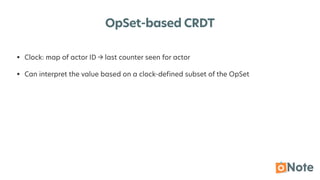Utilizing Point-in-Time Queries in Event-Based Systems, Bobby Calderwood | Current 2022
- 1. Bobby Calderwood — October 2022 Absolute Consistency: Utilizing Point-in-Time Queries in Event-Based Systems
- 2. The goal and the problem • My name is Bobby, and my team makes https://oNote.com • Our goal is to help software teams design, implement, and operate event-driven systems • Design with your team on our collaborative Event Modeling canvas • Implement via schema design, code generation, and functional domain modeling • Operate systems whose state is consistent and evident at all times
- 3. Systems whose state is consistent and evident at all times
- 4. Correlating Business Events with Versioned Read Models
- 5. Correlating Business Events with Versioned Read Models
- 6. Correlating Business Events with Versioned Read Models
- 7. Examples of Point-in-Time Queryable Data Stores • Git (content-addressed) • Datomic/XTDB (EAVT fact-based) • Certain CRDTs • Materialize/CockroachDB/Snow fl ake/BigQuery • Traditional RDBMSs via temporal tables and SQL FOR SYSTEM_TIME and AS OF • Domain speci fi c (e.g. our own Event indexing service)
- 8. Characteristics of PiT Queryable Data Stores • Immutable/append only, often log based • New facts supersede/succeed old ones in a speci fi c way • Often (but not always) able to evict data for regulatory/compliance reasons, while maintaining causal integrity • Time/causal order has a fi rst-class representation, a system “clock”
- 9. Why would I need this?
- 10. Why would I need Git?
- 11. — Rich Hickey, Database as a Value, GOTO 2012 If you have a business, you can’t make decisions if you don’t know what happened before yesterday.
- 12. Stable Basis for Decisions • Issue the same query and get the same results, even as the system makes ongoing progress • Multiple distributed participants in the system can agree on and make decisions based on consistent point-in-time state • System basis/clock can be serialized, sent, stored, etc. to coordinate reads across participants and time
- 13. Multiversion Concurrency Control • With a stable basis for query, we can ensure that writes happen against last-seen state, or else abort • GET /foos -> query DB at latest basis, include that basis in e.g. form data on page • PUT /foos/bar -> write to DB unless basis is greater than the one contained in request • Ensures Command processing of PUT request emits Events based on immediate predecessor of relevant state or not at all • No more clobbering other users’ (or browser tabs’) writes with decisions based on stale data!
- 14. Support Different Data Access Patterns • Some data access pattern workloads are long-running and/or tolerate staleness • Other data access patterns require more current data • These queries put different load on OLTP data stores, might affect availability differently
- 15. Full Context, Traceability, and Transparency • Why did we make this decision at that point in the past? • What changed from then to now? • Time travel queries! • What caused this particular problem? • Audit, compliance, BI, etc. • Analytics often aren’t enough to detect qualitative changes
- 16. Business recovery or reconciliation of errors • Like git blame, but for data • Speeds up time to recovery from business errors • Detect patterns to preemptively catch similar errors in future • Example: Service Member Civil Relief Act
- 17. How does it work in practice?
- 18. Datomic and XTDB (EAVT fact-based) • Clock: monotonically increasing integer identifying each transaction • Transactions are fi rst-class entities, so we can add Event ID as metadata on the transaction • Correlation and traceability • Enables query as-of a particular Event ID!
- 19. Datomic and XTDB (EAVT fact-based) • TODO: code listing
- 20. OpSet-based CRDT • Clock: map of actor ID -> last counter seen for actor • Can interpret the value based on a clock-de fi ned subset of the OpSet
- 21. OpSet-based CRDT • TODO: code listing
- 22. Domain Specific: Event Indexing Service • Clock: map of stream name -> count of events on stream, shortens to overall count of events across all streams • Can query state of any stream at a given clock state • Supports MVCC on write: assert that a given stream must be at a particular revision, else fail appending the event
- 23. Domain Specific: Event Indexing Service • TODO: code listing
- 24. Putting it all together: oNote Event Model Repository
- 25. Event Clock and CRDT Clock • Event Clock from our event indexing service • Map of stream -> event count • Used for MVCC and to fetch fi ne-grained streams per entity • CRDT Sync operation • Appends an Event with a CRDT patch based on client clock and server clock to Event Stream • Responds with patch to bring client up to latest server clock • CRDT query: fetch Event Model at a particular clock state
- 26. Syncing with Git Hosts • Addition of CRDT patch fi le to con fi gured directory syncs CRDT state with speci fi c Git SHA • Changes can come from either: • oNote UI as Sync operations • Git host via branch merges, etc. • Kafka-based event processor ensures all changes are merged and made available in oNote app and in con fi gured Git repo
- 27. Conclusion • Event Log + versioned Read Models provide: • Fully consistent point-in-time state that results from each business event • Transparency, analytics, audit trail for each state transition in system • Kafka + Event indexing provide a meta-Read Model for Events on streams, enabling fi ne-grained streams and MVCC for event-based applications • Kafka + CRDT + Git hosting enables versioned and history-preserving Event Model repository for oNote
- 28. Thank you!




























